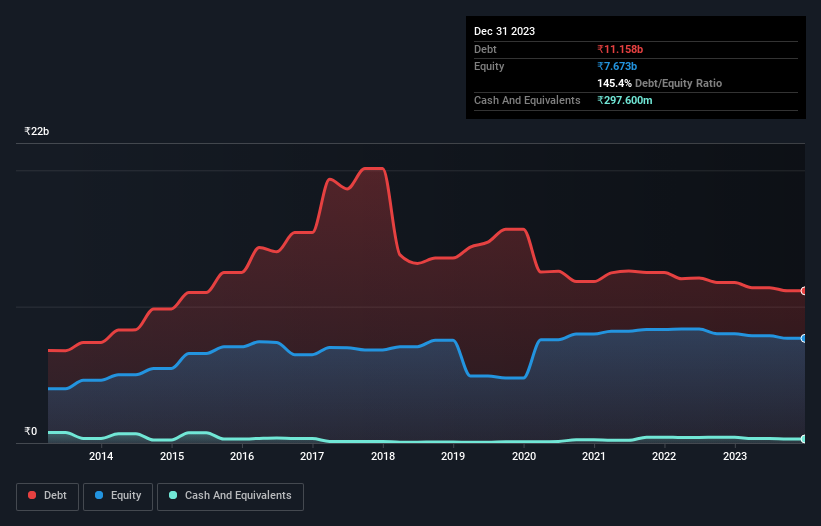David Iben put it well when he said, 'Volatility is not a risk we care about. What we care about is avoiding the permanent loss of capital.' When we think about how risky a company is, we always like to look at its use of debt, since debt overload can lead to ruin. Importantly, MBL Infrastructures Limited (NSE:MBLINFRA) does carry debt. But the real question is whether this debt is making the company risky.
Why Does Debt Bring Risk?
Debt assists a business until the business has trouble paying it off, either with new capital or with free cash flow. Part and parcel of capitalism is the process of 'creative destruction' where failed businesses are mercilessly liquidated by their bankers. However, a more frequent (but still costly) occurrence is where a company must issue shares at bargain-basement prices, permanently diluting shareholders, just to shore up its balance sheet. By replacing dilution, though, debt can be an extremely good tool for businesses that need capital to invest in growth at high rates of return. The first step when considering a company's debt levels is to consider its cash and debt together.
View our latest analysis for MBL Infrastructures
What Is MBL Infrastructures's Debt?
As you can see below, MBL Infrastructures had ₹11.2b of debt at September 2023, down from ₹11.8b a year prior. However, it also had ₹297.6m in cash, and so its net debt is ₹10.9b.

How Healthy Is MBL Infrastructures' Balance Sheet?
We can see from the most recent balance sheet that MBL Infrastructures had liabilities of ₹8.14b falling due within a year, and liabilities of ₹13.4b due beyond that. Offsetting these obligations, it had cash of ₹297.6m as well as receivables valued at ₹2.10b due within 12 months. So its liabilities total ₹19.2b more than the combination of its cash and short-term receivables.
The deficiency here weighs heavily on the ₹4.91b company itself, as if a child were struggling under the weight of an enormous back-pack full of books, his sports gear, and a trumpet. So we definitely think shareholders need to watch this one closely. After all, MBL Infrastructures would likely require a major re-capitalisation if it had to pay its creditors today. There's no doubt that we learn most about debt from the balance sheet. But it is MBL Infrastructures's earnings that will influence how the balance sheet holds up in the future. So if you're keen to discover more about its earnings, it might be worth checking out this graph of its long term earnings trend.
Over 12 months, MBL Infrastructures made a loss at the EBIT level, and saw its revenue drop to ₹1.4b, which is a fall of 6.5%. That's not what we would hope to see.
Caveat Emptor
Over the last twelve months MBL Infrastructures produced an earnings before interest and tax (EBIT) loss. To be specific the EBIT loss came in at ₹477m. Combining this information with the significant liabilities we already touched on makes us very hesitant about this stock, to say the least. Of course, it may be able to improve its situation with a bit of luck and good execution. Nevertheless, we would not bet on it given that it lost ₹331m in just last twelve months, and it doesn't have much by way of liquid assets. So while it's not wise to assume the company will fail, we do think it's risky. When analysing debt levels, the balance sheet is the obvious place to start. However, not all investment risk resides within the balance sheet - far from it. We've identified 2 warning signs with MBL Infrastructures (at least 1 which makes us a bit uncomfortable) , and understanding them should be part of your investment process.
At the end of the day, it's often better to focus on companies that are free from net debt. You can access our special list of such companies (all with a track record of profit growth). It's free.
New: Manage All Your Stock Portfolios in One Place
We've created the ultimate portfolio companion for stock investors, and it's free.
• Connect an unlimited number of Portfolios and see your total in one currency
• Be alerted to new Warning Signs or Risks via email or mobile
• Track the Fair Value of your stocks
Have feedback on this article? Concerned about the content? Get in touch with us directly. Alternatively, email editorial-team (at) simplywallst.com.
This article by Simply Wall St is general in nature. We provide commentary based on historical data and analyst forecasts only using an unbiased methodology and our articles are not intended to be financial advice. It does not constitute a recommendation to buy or sell any stock, and does not take account of your objectives, or your financial situation. We aim to bring you long-term focused analysis driven by fundamental data. Note that our analysis may not factor in the latest price-sensitive company announcements or qualitative material. Simply Wall St has no position in any stocks mentioned.
About NSEI:MBLINFRA
MBL Infrastructures
Engages in the execution of civil engineering infrastructure projects in India.
Slight risk with worrying balance sheet.
Similar Companies
Market Insights
Community Narratives



